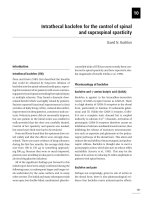Lecture Math for the pharmacy technician: Concepts and calculations: Chapter 1 – Lynn M. Egler, Kathryn A. Booth
Bạn đang xem bản rút gọn của tài liệu. Xem và tải ngay bản đầy đủ của tài liệu tại đây (2.95 MB, 70 trang )
Math for the Pharmacy Technician:
Concepts and Calculations
Egler • Booth
Chapter 1: Numbering Systems
and Mathematical Review
and Mathematical Review
McGrawHill
©2010 by the McGraw-Hill Companies, Inc All Rights Reserved
12
Numbering Systems and
Mathematical Review
McGrawHill
©2010 by the McGrawHill Companies, Inc All Rights Reserved
13
Learning Outcomes
When you have successfully completed Chapter 1, you will have mastered
skills to be able to:
Identify and determine the values of Roman and
Arabic numerals.
Understand and compare the values of fractions
in various formats.
Accurately add, subtract, multiply, and divide
fractions and decimals.
Convert fractions to mixed numbers and
decimals.
McGrawHill
©2010 by the McGrawHill Companies, Inc All Rights Reserved
14
Learning Outcomes (con’t)
Recognize the format of decimals and measure
their relative values.
Round decimals to the nearest tenth, hundredth,
or thousandth.
Describe the relationship among percents,
ratios, decimals, and fractions.
McGrawHill
©2010 by the McGrawHill Companies, Inc All Rights Reserved
15
Introduction
Basic math skills are building blocks for
accurate dosage calculations.
You must be confident in your math skills.
A minor mistake can mean major errors in
the patient’s medication.
McGrawHill
©2010 by the McGrawHill Companies, Inc All Rights Reserved
16
Arabic Numbers
Arabic numbers include all numbers used
today.
Numbers are written using the digits 0, 1,
2, 3, 4, 5, 6, 7, 8, and 9.
You can write whole numbers, decimals,
and fractions by simply combining digits.
McGrawHill
©2010 by the McGrawHill Companies, Inc All Rights Reserved
17
Arabic Numbers
(con’t)
Example
Example
The Arabic digits 2 and 5 can be combined to write:
The whole number 25
The decimal 2.5
The fraction 2/5
The same two digits are used in each of the above Arabic
numbers but each have different values.
McGrawHill
©2010 by the McGrawHill Companies, Inc All Rights Reserved
18
Roman Numerals
Are used sometimes
in drug orders
You need to
understand how to
change Roman
numeral into Arabic
numbers in order to
do dosage
calculations
McGrawHill
Commonly used
Roman numerals
ss = ½
I = 1
V = 5
X = 10
They may be written
in lower or
uppercase
©2010 by the McGrawHill Companies, Inc All Rights Reserved
19
Combining Roman Numerals
When reading a Roman numeral containing
more than 1 letter, follow these two steps:
1. If any letter with a smaller value appears before a
letter with a larger value, subtract the smaller
value from the larger value.
2. Add the value of all the letters not affected by
Step 1 to those that were combined.
McGrawHill
©2010 by the McGrawHill Companies, Inc All Rights Reserved
110
Combining Roman Numerals
(con’t)
Example
Example
IX = 10 –1 = 9
XIV = 10 + (51) = 14
McGrawHill
Roman numerals from
1 to 30 are the ones
you are most likely to
see in doctors’ orders.
Be familiar with these
to read orders
correctly.
©2010 by the McGrawHill Companies, Inc All Rights Reserved
111
Fractions and Mixed Numbers
Measure a portion or part of a whole
amount
Written two ways:
Common fractions
Decimals
McGrawHill
©2010 by the McGrawHill Companies, Inc All Rights Reserved
112
Common Fractions
Represent equal parts of a whole
Consist of two numbers and a fraction bar
Written in the form:
Numerator (top part of the fraction) = part of whole
Denominator (bottom part of the fraction) represents the whole
one part of the whole
the whole
McGrawHill
©2010 by the McGrawHill Companies, Inc All Rights Reserved
1
5
113
Common Fractions (con’t)
Scored (marked) tablet for 2 parts
You administer 1 part of that tablet each day
You would show this as 1 part of
2 wholes or ½
Read it as “one half”
McGrawHill
©2010 by the McGrawHill Companies, Inc All Rights Reserved
114
Fraction Rule
When the denominator is 1, the fraction equals the
number in the numerator.
Example
Example
4
1 4,
100
1 100
Check these equations by treating each
fraction as a division problem.
McGrawHill
©2010 by the McGrawHill Companies, Inc All Rights Reserved
115
Mixed Numbers
Mixed numbers
combine a whole
number with a
fraction.
Example
Example
2
3
2 (two and twothirds)
Fractions with a value greater than 1 are
written as mixed numbers.
McGrawHill
©2010 by the McGrawHill Companies, Inc All Rights Reserved
116
Mixed Numbers (con’t)
If the numerator of the fraction is less than the
denominator, the fraction has a value of < 1.
If the numerator of the fraction is equal to the
denominator, the fraction has a value =1.
If the numerator of the fraction is greater than the
denominator, the fraction has a value > 1.
McGrawHill
©2010 by the McGrawHill Companies, Inc All Rights Reserved
117
Mixed Numbers (con’t)
To convert a fraction to a mixed number:
1. Divide the numerator by the denominator. The
result will be a whole number plus a remainder.
2. Write the remainder as the number over the
original denominator.
3. Combine the whole number and the fraction
remainder. This mixed number equals the original
fraction.
Only applied when the numerator is greater
than the denominator
McGrawHill
©2010 by the McGrawHill Companies, Inc All Rights Reserved
118
Mixed Numbers (con’t)
11
Convert to a mixed
Example
Example
4
number.
1. Divide the numerator by the denominator
11
2. = 2 R3 (R3 means a remainder of 3)
4
3. The result is the whole number 2 with a
remainder of 3
4. Write the remainder over the whole ¾
5. Combine the whole number and the fraction 2+ ¾
McGrawHill
©2010 by the McGrawHill Companies, Inc All Rights Reserved
119
Mixed Numbers (con’t)
1
5
To convert a mixed number ( ) to a fraction:
3
1. Multiply the whole number (5) by the
denominator (3) of the fraction ( )
1
3
5x3 = 15
2. Add the product from Step 1 to the numerator
of the fraction
15+1 = 16
McGrawHill
©2010 by the McGrawHill Companies, Inc All Rights Reserved
120
Mixed Numbers (con’t)
To convert a mixed number to a fraction:
3.
Write the sum from Step 2 over the original
denominator
16
3
4.
The result is a fraction equal to original mixed number.
1 16
5
Thus
3
3
McGrawHill
©2010 by the McGrawHill Companies, Inc All Rights Reserved
121
Review and Practice
17
What is the numerator in ?
100
Answer = 17
4
What is the denominator in ?
100
Answer = 100
Twelve patients are in the hospital ward. Four
have type A blood. What fraction do not have
type A blood? 8
Answer =
McGrawHill
12
©2010 by the McGrawHill Companies, Inc All Rights Reserved
122
Equivalent Fractions
Two fractions written differently that have
the same value = equivalent fractions.
Example
Example
4
8
3
same as same as
6
Find equivalent
fractions for
1 2
X
3 2
McGrawHill
2
4
1
3
2
6
©2010 by the McGrawHill Companies, Inc All Rights Reserved
123
Equivalent Fractions (con’t)
To find an equivalent fraction, multiply or divide
both the numerator and denominator by the
same number.
Exception:
The numerator and denominator cannot be
multiplied or divided by zero.
McGrawHill
©2010 by the McGrawHill Companies, Inc All Rights Reserved
124
Equivalent Fractions (con’t)
To find missing numerator in an equivalent
fraction:
Example
Example
2
3
?
12
a. Divide the larger denominator by the smaller one:
12 divided by 3 = 4
b. Multiply the original numerator by the quotient from
Step a: 2x4=8
2
3
McGrawHill
8
12
©2010 by the McGrawHill Companies, Inc All Rights Reserved
125
Equivalent Fractions (con’t)
Find 2 equivalent fractions for .
1
10
Answers
2 4
,
20 40
?
8
Find the missing numerator .
16
Answer 128
McGrawHill
©2010 by the McGrawHill Companies, Inc All Rights Reserved









